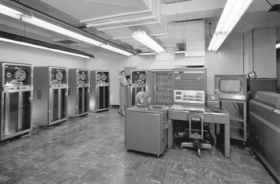User:Pgr0/IBM 704

The IBM 704,[1] the first mass-produced computer with floating point arithmetic hardware, was introduced by IBM in April, 1954. The 704 was significantly improved over the IBM 701 in terms of architecture as well as implementation, and was not compatible with its predecessor.
Changes from the 701 included the use of core memory (instead of Williams tubes) and addition of three index registers. To support these new features, the instructions were expanded to use the full 36-bit word. The new instruction set became the base for the IBM 700/7000 series scientific computers.
To quote the IBM 704 Manual of operation (see external links below):
- The type 704 Electronic Data-Processing Machine is a large-scale,
- high-speed electronic calculator controlled by an internally stored
- program of the single address type.
IBM stated that the device was capable of executing up to 40,000 instructions per second. IBM sold 123 type 704 systems from 1955 to 1960.
The programming languages FORTRAN and LISP were first developed for the 704, as was MUSIC, the first computer music program by Max Mathews.
In 1962 physicist John Larry Kelly, Jr created one of the most famous moments in the history of Bell Labs by using an IBM 704 computer to synthesize speech. Kelly's voice recorder synthesizer vocoder recreated the song Daisy Bell, with musical accompaniment from Max Mathews. Arthur C. Clarke of 2001: A Space Odyssey fame was coincidentally visiting friend and colleague John Pierce at the Bell Labs Murray Hill facility at the time of this remarkable speech synthesis demonstration and was so impressed that he used it in the climactic scene of his novel and screenplay for 2001: A Space Odyssey,[2] where the HAL 9000 computer sings the same song.[3]
Ed Thorp also used the IBM 704 as a research tool, investigating the probabilities of winning while developing his blackjack gaming theory.[4][5] He used Fortran to formulate the equations of his research model.
The IBM 704 was used as the official tracker for the Smithsonian Astrophysical Observatory Operation Moonwatchin the fall of 1957. See The M.I.T. Computation Center and Operation Moonwatch. IBM provided four staff scientists to aid Smithsonian Astrophysical Observatory scientists and mathematicians in the calculation of satellite orbits: Dr. Giampiero Rossoni, Satellite Coordinator of IBM Applied Science (Cambridge), Dr. John Greenstadt, Thomas Apple and Richard Hatch.
Instruction and data formats[edit]
The basic instruction format was a 3-bit prefix, 15-bit decrement, 3-bit tag, and 15-bit address. The prefix field specified the class of instruction. The decrement field often contained an immediate operand to modify the results of the operation, or was used to further define the instruction type. The three bits of the tag specified any combination of three "decrement registers", an early kind of index registers in which the contents of the registers were subtracted from the address to produce an effective address. The address field either contained an address or an immediate operand.
- Fixed point numbers were stored in binary sign/magnitude format.
- Single precision floating point numbers had a magnitude sign, an 8-bit excess-128 exponent and a 29 bit magnitude
- Alphanumeric characters were 6-bit BCD, packed six to a word.
References[edit]
- ^ 704 photos from IBM
- ^ Arthur C. Clarke online Biography
- ^ Bell Labs: Where "HAL" First Spoke (Bell Labs Speech Synthesis website)
- ^ Discovery channel documentary with interviews by Ed and Vivian Thorp
- ^ The Tech (MIT) "Thorpe, 704 Beat Blackjack" Vol. 81 No. I Cambridge, Mass., Friday, February 10, 1961
Further reading[edit]
- Charles J. Bashe, Lyle R. Johnson, John H. Palmer, Emerson W. Pugh, IBM's Early Computers (MIT Press, Cambridge, 1986)
- Steven Levy, Hackers: Heroes of the Computer Revolution
External links[edit]
- IBM (...) TYPE 704 Manual of operation: Preliminary edition (scans of pp. 1–39)
- Complete Manual of Operation and other IBM 704 manuals (PDF file)
- Applications and installations of the IBM 704 Data Processing System – From A Third Survey of Domestic Electronic Digital Computing Systems, Report No. 1115, March 1961, by Martin H. Weik. Ballistic Research Laboratories, Aberdeen Proving Ground, Maryland. Text format conversion of source paper document at the Computer History Museum (http://www.computerhistory.org).
